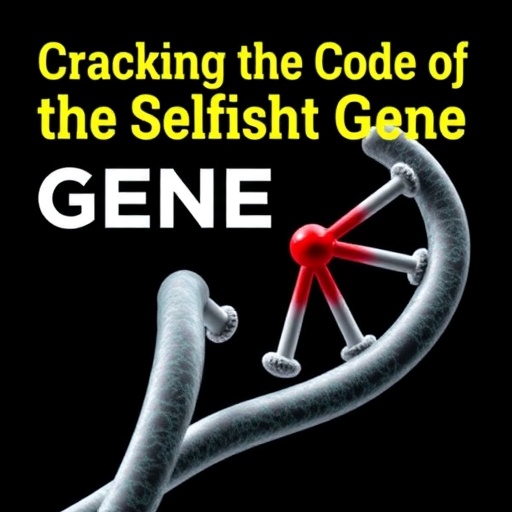Scientists Uncover Genetic Mechanism That Could Revolutionize Insect Population Control
In a groundbreaking study poised to reshape our approach to managing insect populations, researchers from the University of Sheffield have unveiled the intricate workings of a “selfish gene” capable of skewing inheritance patterns and potentially driving insect populations to collapse. This genetic phenomenon, known as meiotic drive, defies conventional Mendelian inheritance by favoring its own transmission over alternative gene variants, disrupting the classic 50/50 probability of genetic passage to offspring. Such insights offer promising avenues for controlling insects that are notorious vectors of disease and major contributors to agricultural losses worldwide.
At the heart of this discovery lies a detailed molecular exploration of the Malaysian stalk-eyed fly (Teleopsis dalmanni), a species that serves as a natural model to study the effects of selfish genetic elements. Utilizing cutting-edge single-cell RNA sequencing technology, the research team meticulously profiled the gene expression patterns within individual sperm cells during their development. This high-resolution molecular portrait enabled unparalleled insights into how the selfish gene exerts influence over sperm formation and viability, particularly targeting and impairing sperm that carry the Y chromosome.
Meiosis, the specialized cell division responsible for producing gametes, normally ensures a fair and balanced transmission of genetic material, with maternal and paternal alleles each having an equal opportunity to propagate. However, selfish genes have evolved mechanisms to subvert this balance. Meiotic drive genes manipulate the process to disproportionately propagate themselves, often at the expense of competing alleles. In the Malaysian stalk-eyed fly, the selfish gene selectively attacks Y-bearing sperm, reducing their motility and thus skewing the sex ratio of offspring heavily towards females.
This distortion of sex ratios has profound population-level consequences. As the number of males dwindles, reproductive dynamics shift dramatically, leading to reduced genetic diversity and, under sustained pressure, the potential collapse of the population altogether. Dr. Alison Wright, lead investigator of the study, elucidates, “Meiotic drive is an extraordinarily powerful evolutionary force. In natural populations, these selfish genes can shape sex ratios to such extreme degrees that they threaten the very survival of the species. Understanding these mechanisms opens doors to harnessing this genetic phenomenon for targeted pest control.”
The implications for public health and food security are compelling. Insects such as mosquitoes, tsetse flies, and various agricultural pests contribute to disease transmission and crop damage, posing significant global challenges. If meiotic drive mechanisms could be engineered or leveraged to mimic those observed in the stalk-eyed fly, it may become possible to manipulate pest populations—specifically by inducing highly female-biased sex ratios that undermine reproductive capacity and curb population growth.
One of the pivotal breakthroughs of this research lies in its use of single-cell RNA sequencing, a method that profiles the transcriptome—the full range of RNA transcripts present—within individual cells. Applying this technique to the developing sperm cells of the stalk-eyed fly allowed the team to identify gene networks that are selectively activated or repressed in the presence of the selfish gene. These candidate genes are essential to sperm development and function, providing crucial insights into how selfish elements orchestrate their drive at the molecular level.
Dr. Peter Price, the study’s lead author, emphasizes the novelty of this approach: “By dissecting sperm at the single-cell level, we unraveled the complex interplay between normal development and selfish genetic interference. The selfish gene’s ability to sabotage Y-bearing sperm mobility effectively tips the reproductive balance, but the exact molecular pathways involved are now coming into clearer focus.”
From an evolutionary biology perspective, meiotic drive represents a fascinating form of genetic conflict. Selfish genes operate to maximize their transmission, often incurring fitness costs to their host organism. This dynamic can trigger evolutionary arms races, where suppressor genes evolve to counteract drive elements, preserving genetic equilibrium. The Malaysian stalk-eyed fly study provides a window into this evolutionary battlefield, showcasing the balance between selfish genetic advantage and population viability.
The researchers acknowledge that while the stalk-eyed fly itself is not a pest species, it serves as a vital model system. The fundamental principles and molecular mechanisms uncovered here lay the foundation for applying similar strategies to pest insects. The next phase of research will involve probing the origins of these selfish genes and investigating their long-term evolutionary consequences in natural populations, aiming to harness these findings for practical applications.
In conclusion, this study not only deepens our understanding of meiotic drive and selfish gene behavior but also charts a promising course toward novel biocontrol methods. By leveraging natural genetic processes that distort sex ratios and reproductive capability, scientists may soon develop precise tools to combat insect populations that threaten global health and food production, representing a paradigm shift in pest management.
Subject of Research: Animals
Article Title: Single-cell consequences of X-linked meiotic drive in stalk-eyed flies
News Publication Date: 18-Sep-2025
Web References: http://dx.doi.org/10.1371/journal.pgen.1011816
Image Credits: Paul Richards
Keywords: Evolution, Evolutionary developmental biology, Evolutionary ecology, Evolutionary genetics
Tags: agricultural pest managementbreakthroughs in insect population dynamicsdisease vector managementevolutionary biology of insectsgenetic inheritance patternsimplications of selfish genesmeiotic drive in geneticsmodels of genetic researchmolecular biology of sperm developmentpopulation control strategies for insectsselfish gene mechanismssingle-cell RNA sequencing applications





